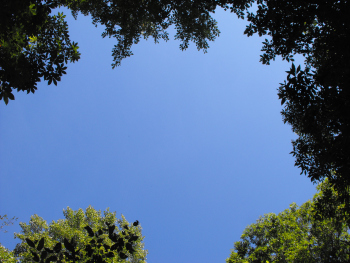
Mimicking treefall gaps in the forest garden
 Tuesday,
Mark and I spent a bit of time working on the forest garden that we
haven't previously talked much about. Unlike the
forest garden we've blogged about extensively,
we're building this one the way Amazonian people have built forest
gardens for hundreds (thousands?) of years --- by encouraging the trees
we find the most useful in an existing forest. This type of
forest garden is most appropriate for big nut trees and other species
which would naturally grow in a mature forest, rather than for the
early successional fruit trees like apples and peaches which need
constant sunlight.
Tuesday,
Mark and I spent a bit of time working on the forest garden that we
haven't previously talked much about. Unlike the
forest garden we've blogged about extensively,
we're building this one the way Amazonian people have built forest
gardens for hundreds (thousands?) of years --- by encouraging the trees
we find the most useful in an existing forest. This type of
forest garden is most appropriate for big nut trees and other species
which would naturally grow in a mature forest, rather than for the
early successional fruit trees like apples and peaches which need
constant sunlight.
The area we chose for
this forest garden is full of young trees which have been growing back
from pasture for just a few decades. Some older trees within the
stand are keepers regardless of their use because I adore old trees,
but most of the forest there is made up of black locust, box-elder,
sassafras, ironwood, dogwood, sourwood, and other small trees. We
added in young seedlings of butternut, persimmon, and Chinese chestnut,
all of which are native or (in the case of the chestnut) replace a
native species wiped out by disease. We also earmarked
some existing trees --- primarily sourwood and black locust --- as
keepers due to their utility as nectar trees for our honeybees.
This forest garden gets
minimal maintenance consisting of rooting out invasives and encouraging
the trees we like. On Tuesday, we cut down a few small trees
around each of our favored trees, mimicking natural treefall gaps and
give our favorites extra light. Or, to be more accurate, Mark cut
down small trees while I stood around and pointed.
Want more in-depth information? Browse through our books.
Or explore more posts by date or by subject.
About us: Anna Hess and Mark Hamilton spent over a decade living self-sufficiently in the mountains of Virginia before moving north to start over from scratch in the foothills of Ohio. They've experimented with permaculture, no-till gardening, trailersteading, home-based microbusinesses and much more, writing about their adventures in both blogs and books.
Want to be notified when new comments are posted on this page? Click on the RSS button after you add a comment to subscribe to the comment feed, or simply check the box beside "email replies to me" while writing your comment.
